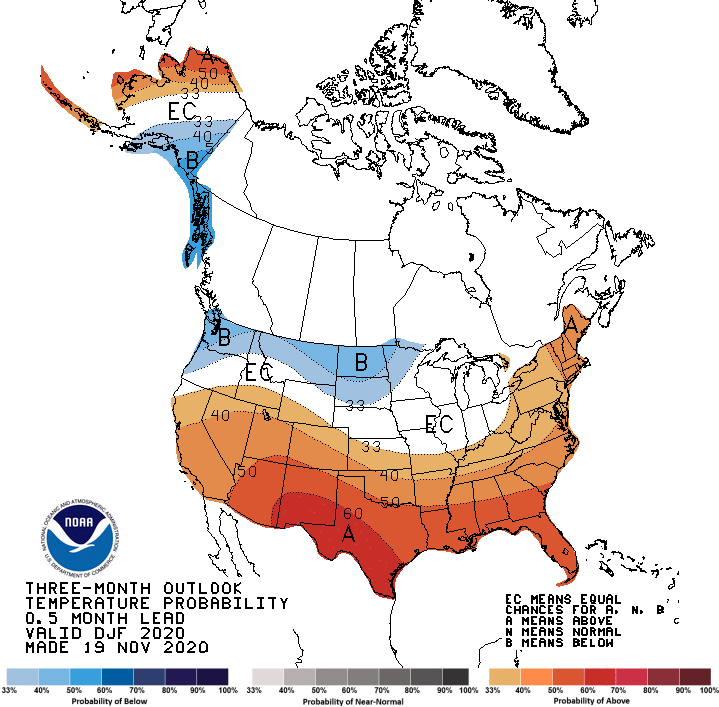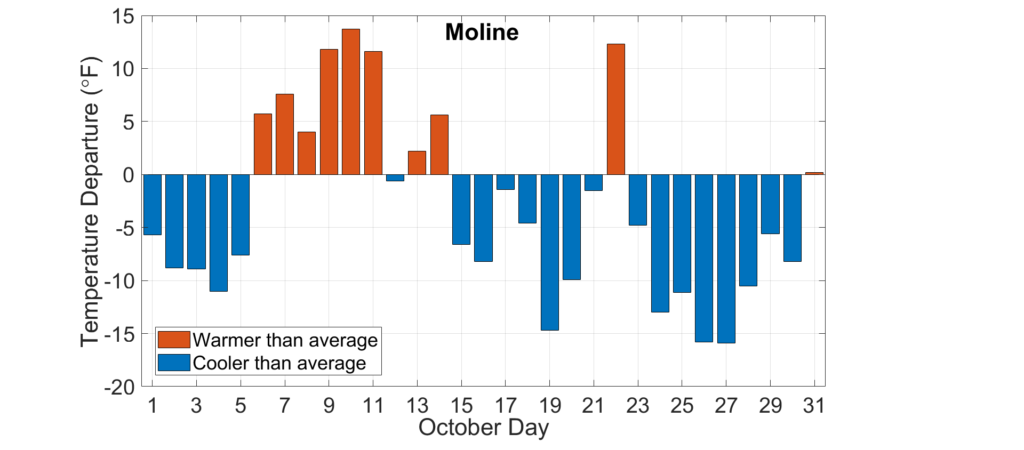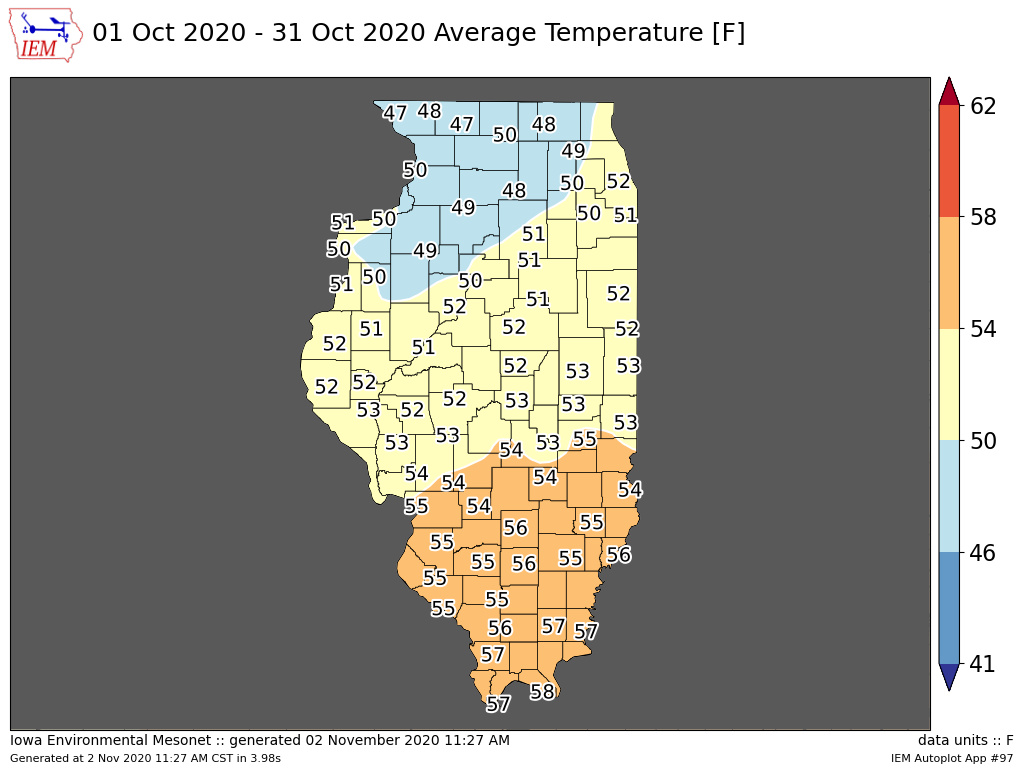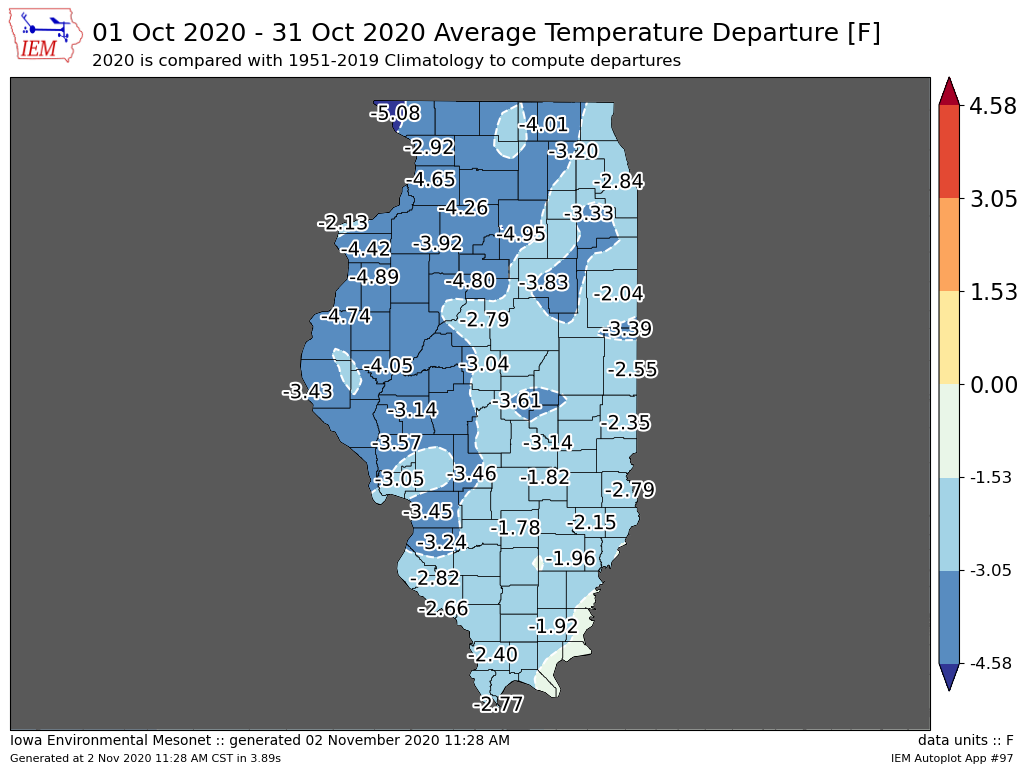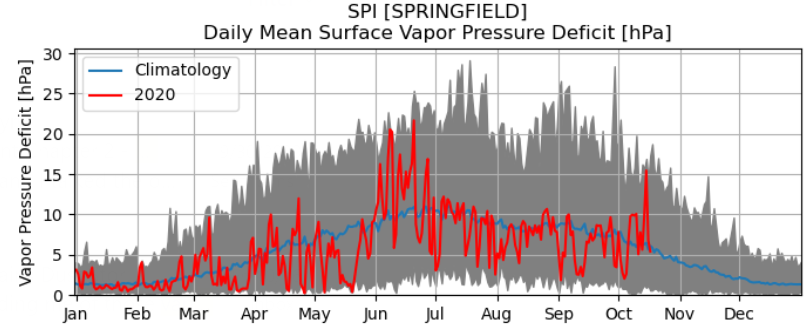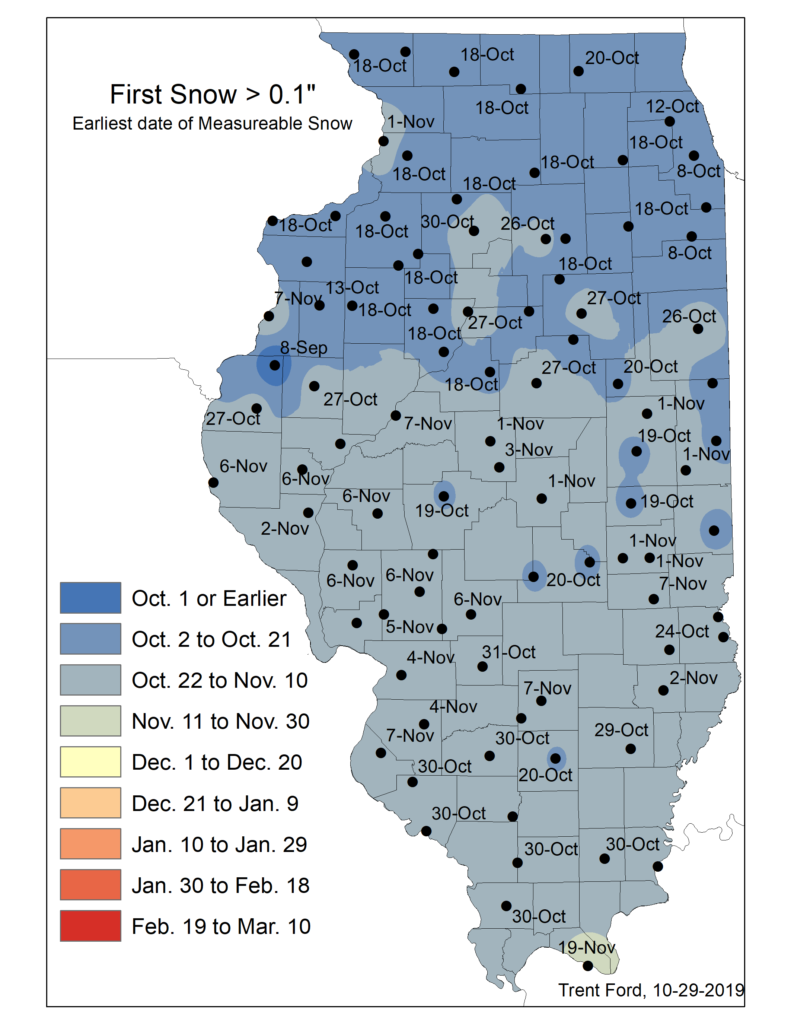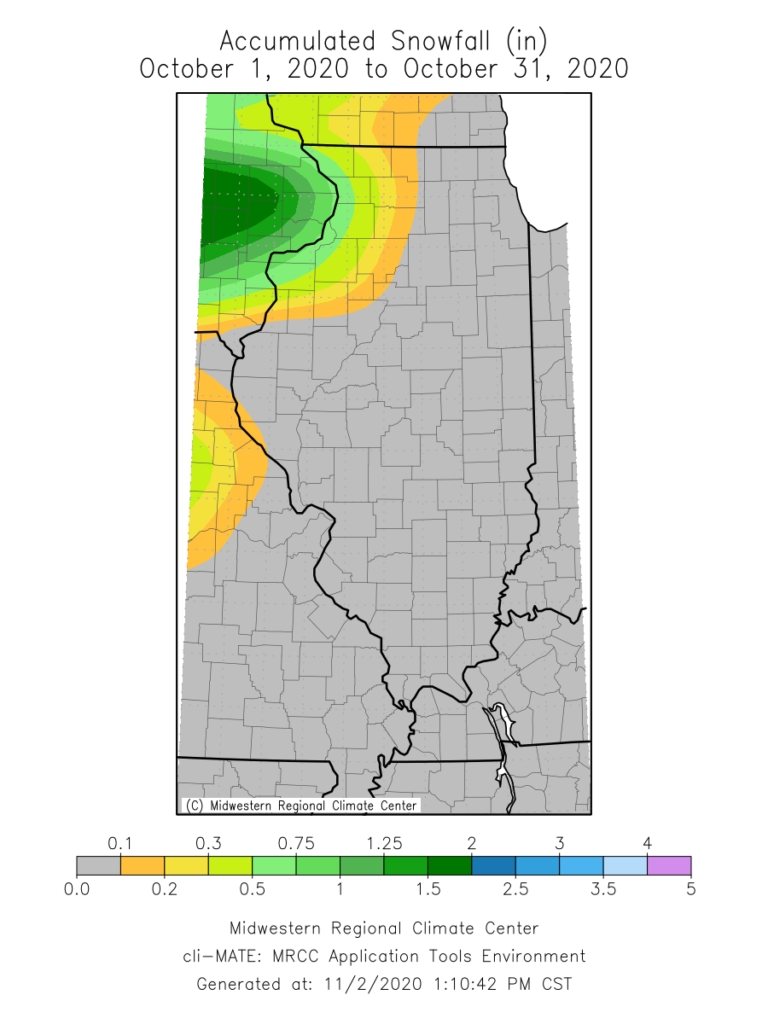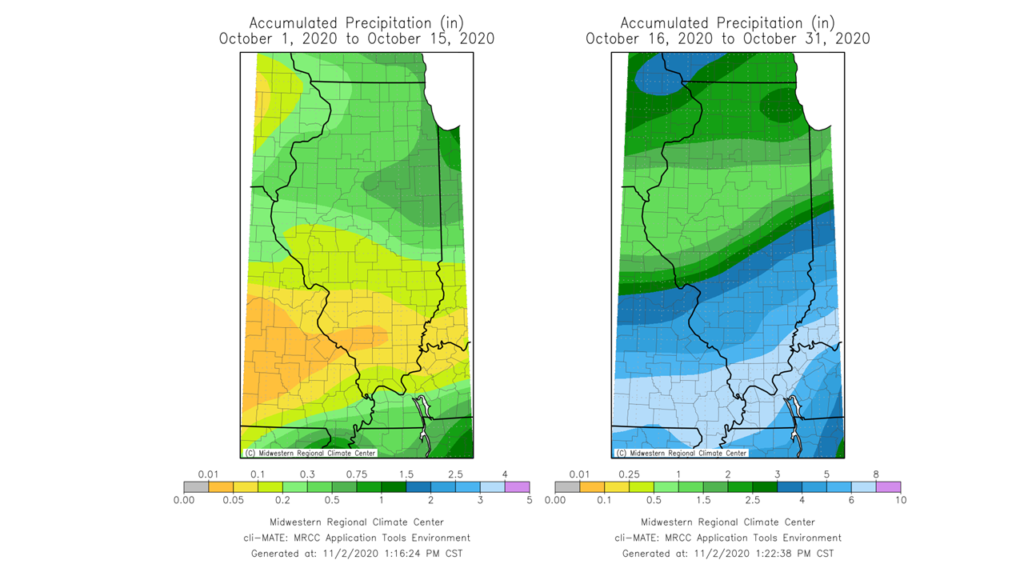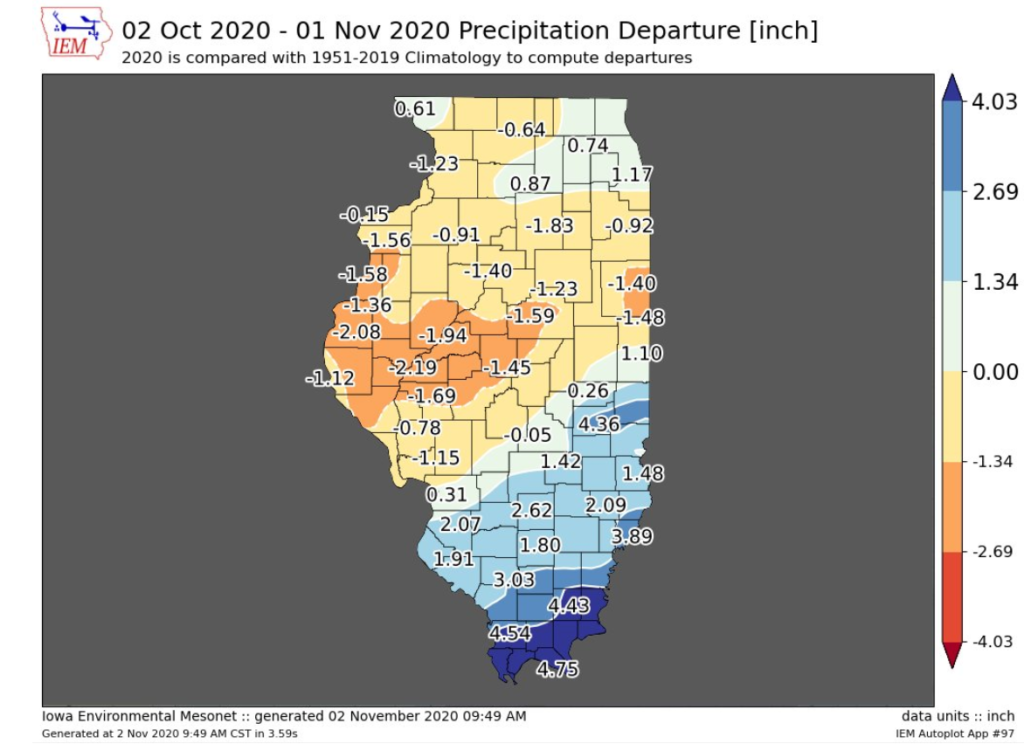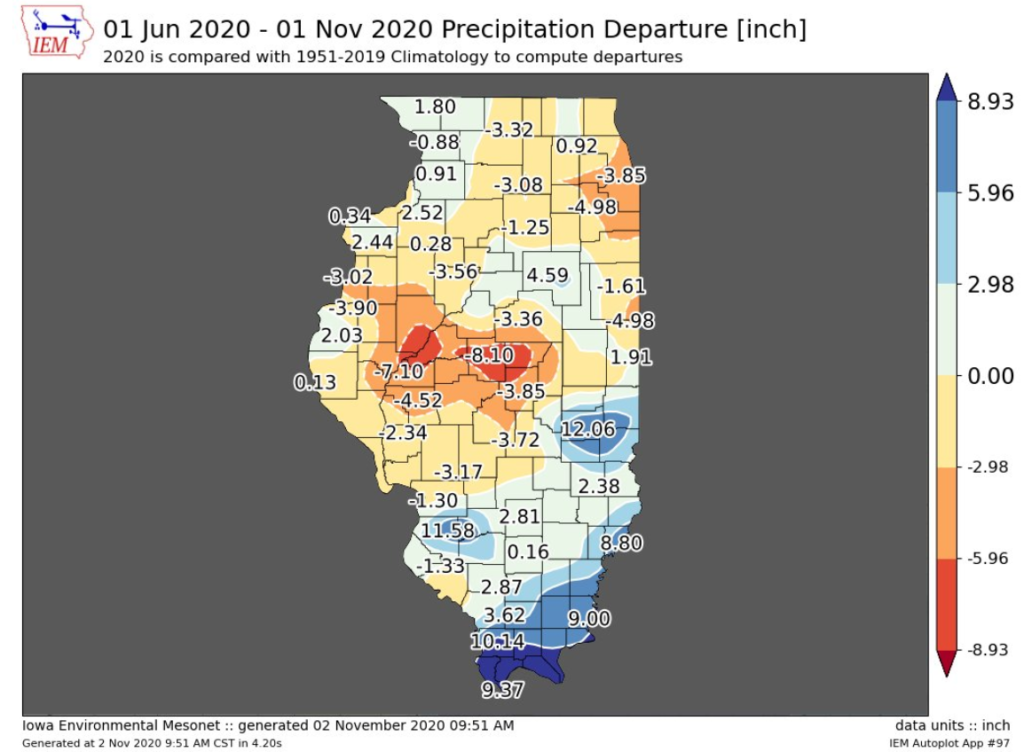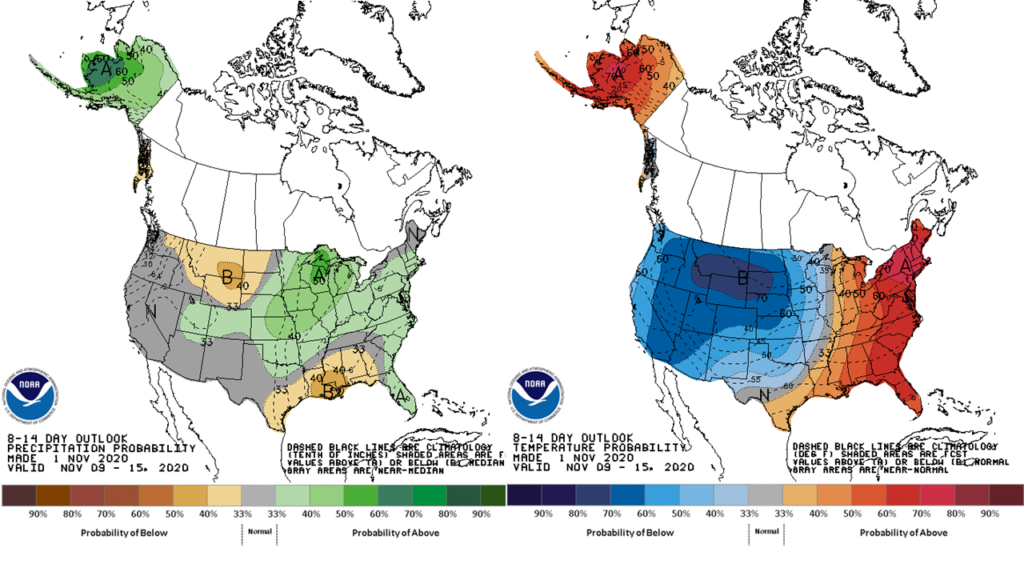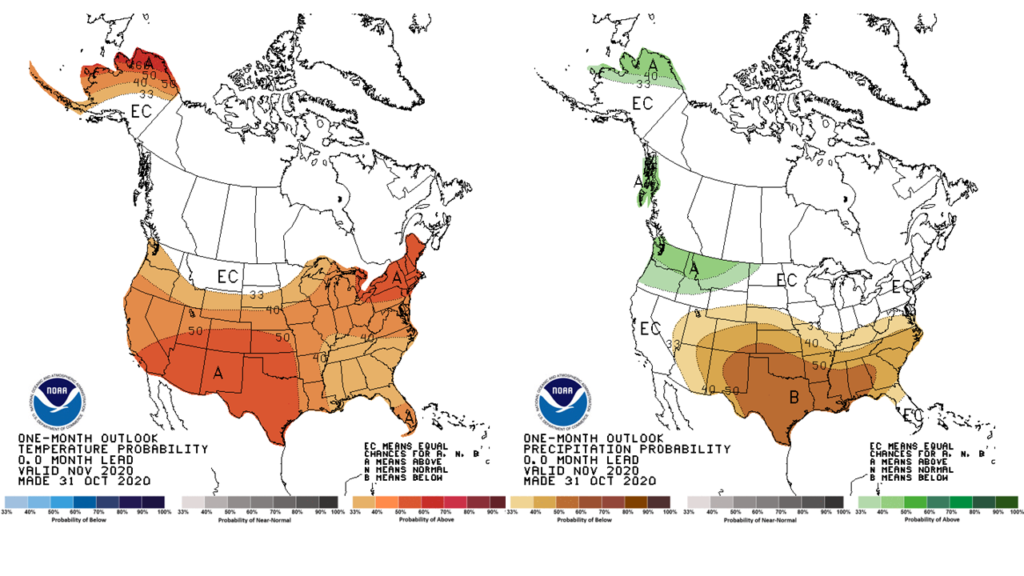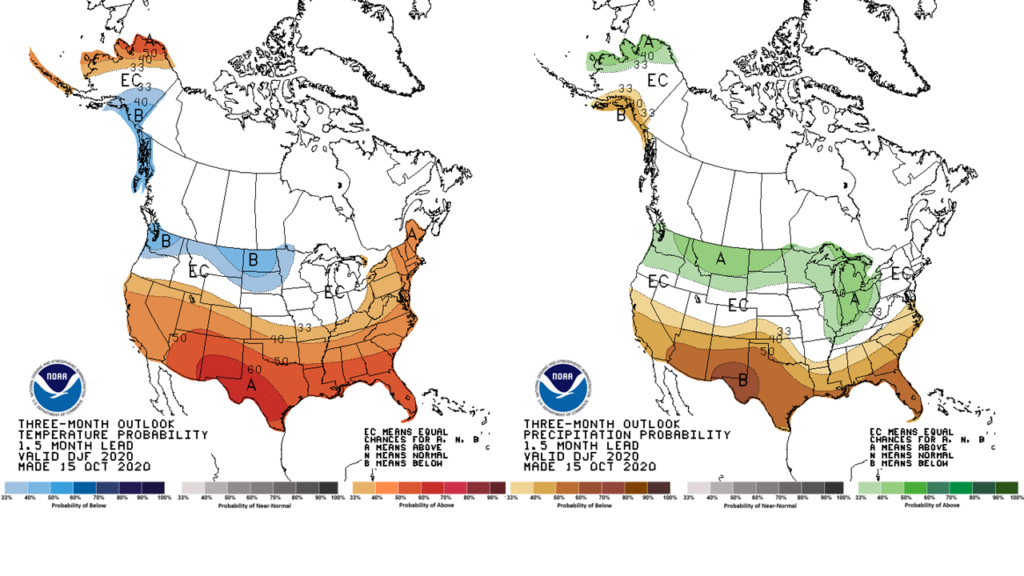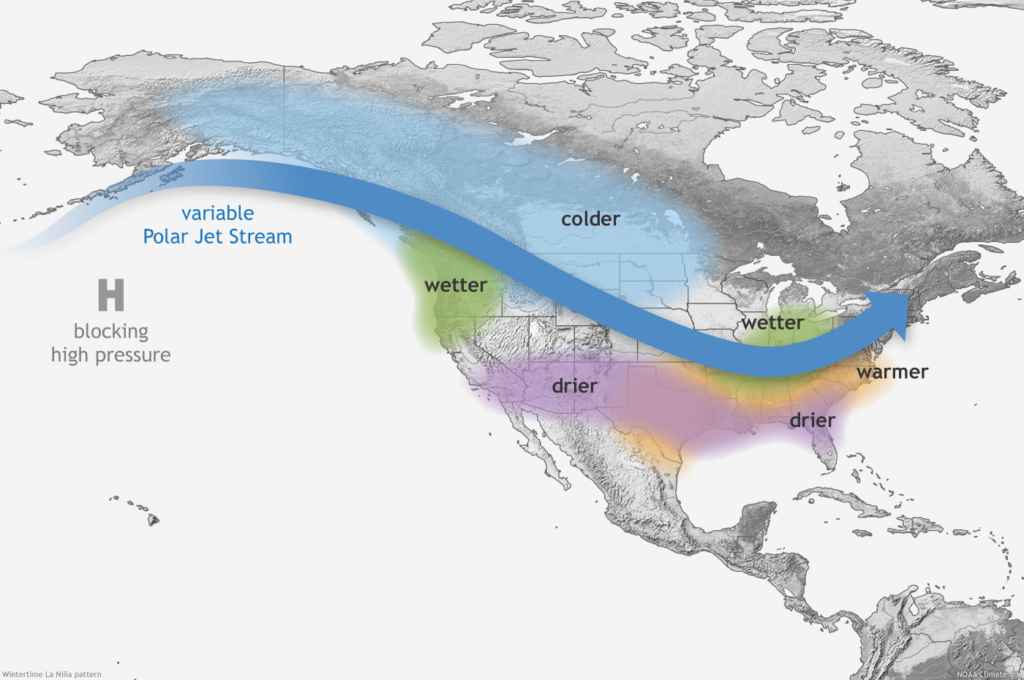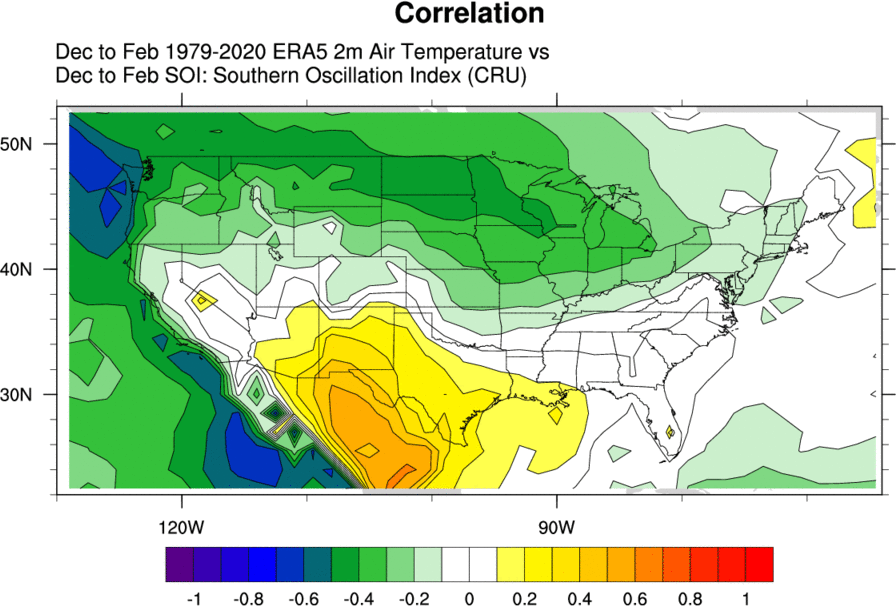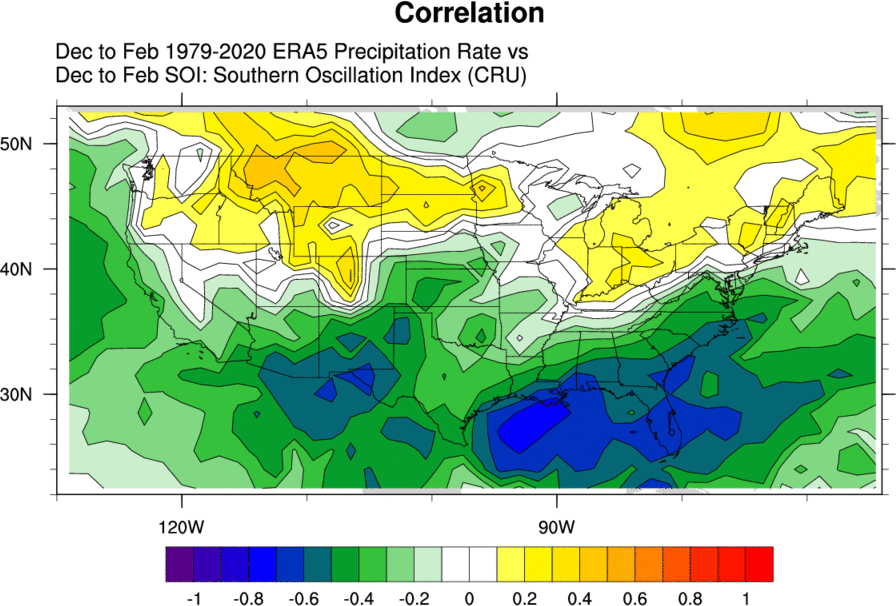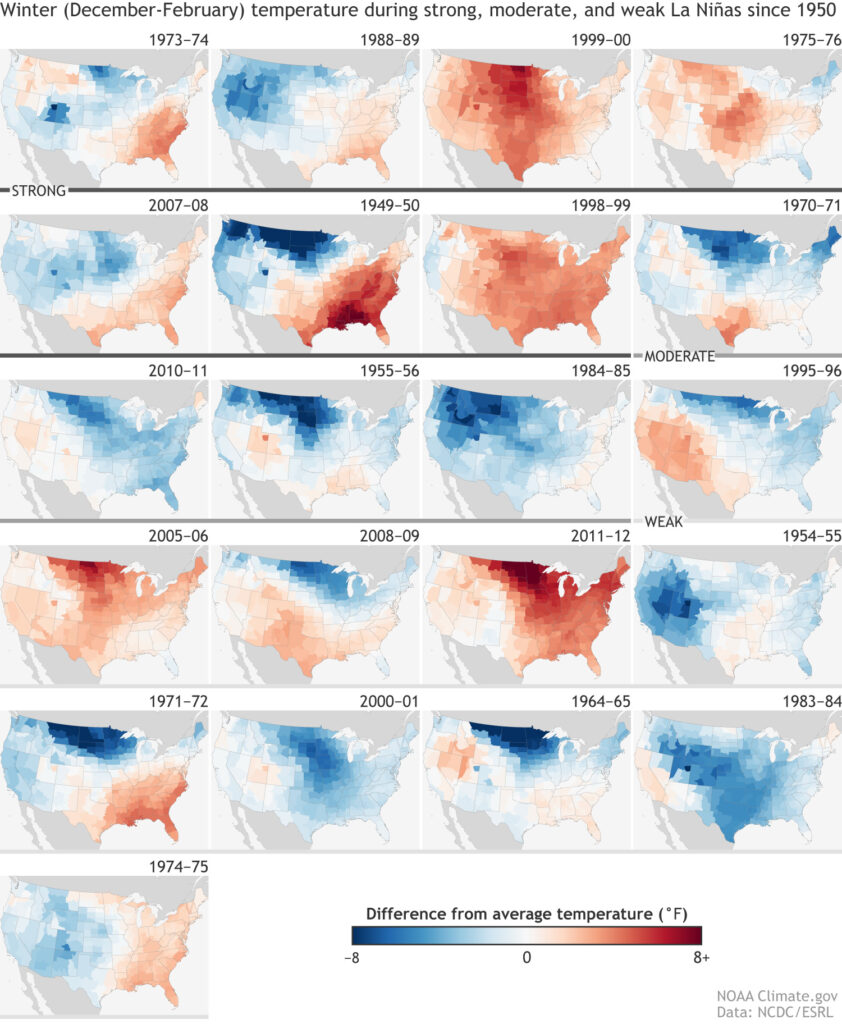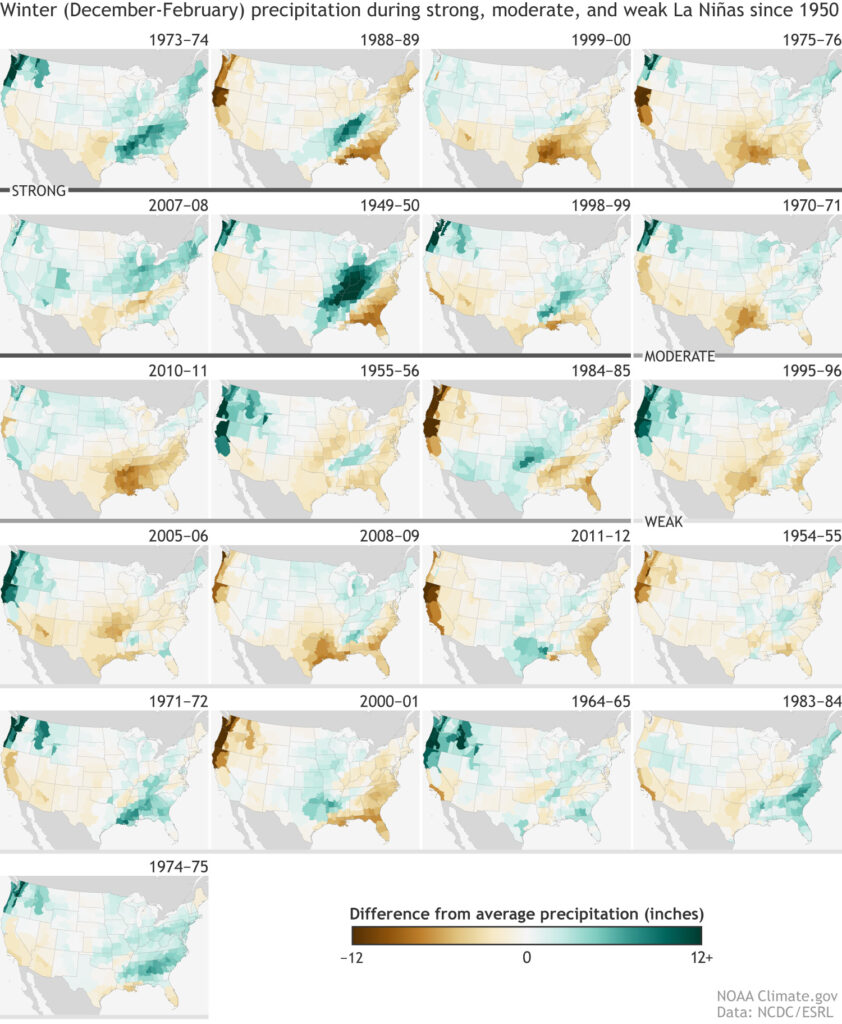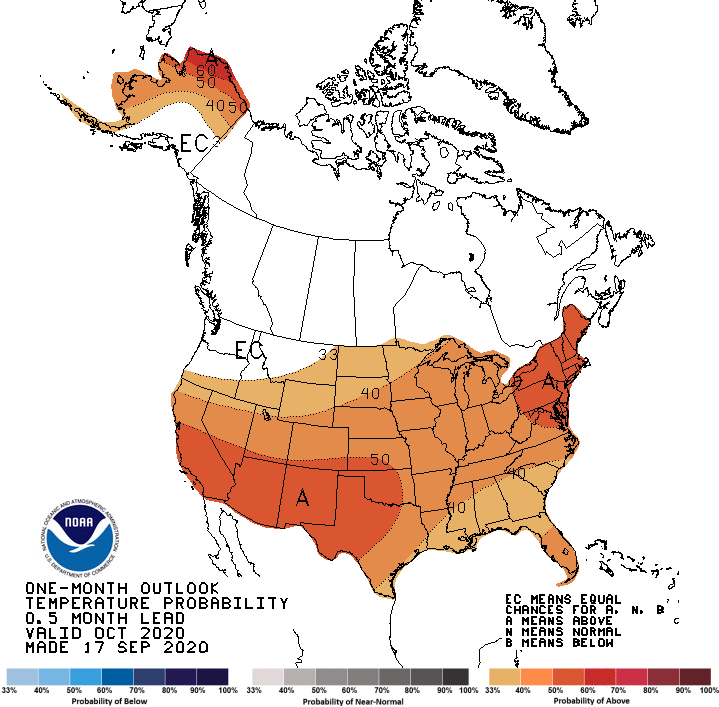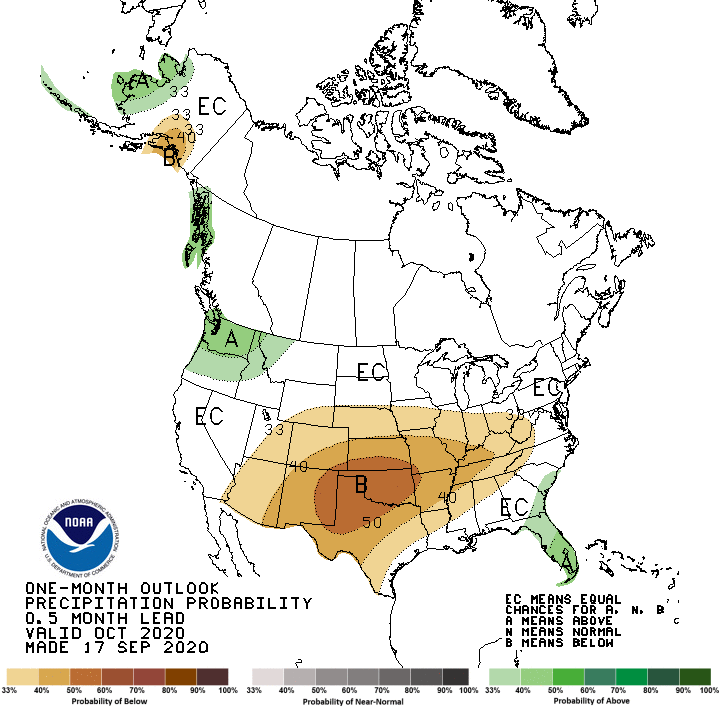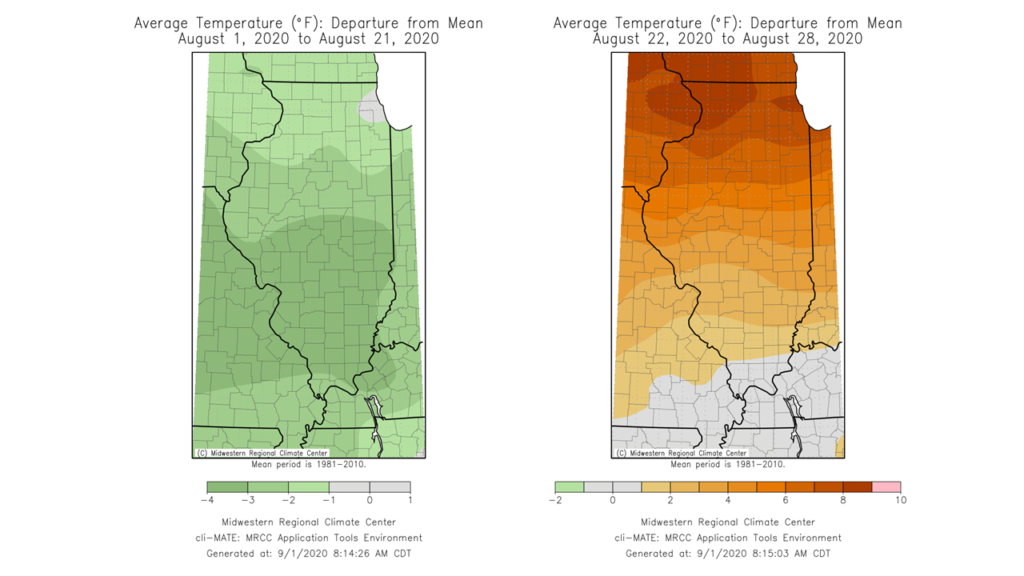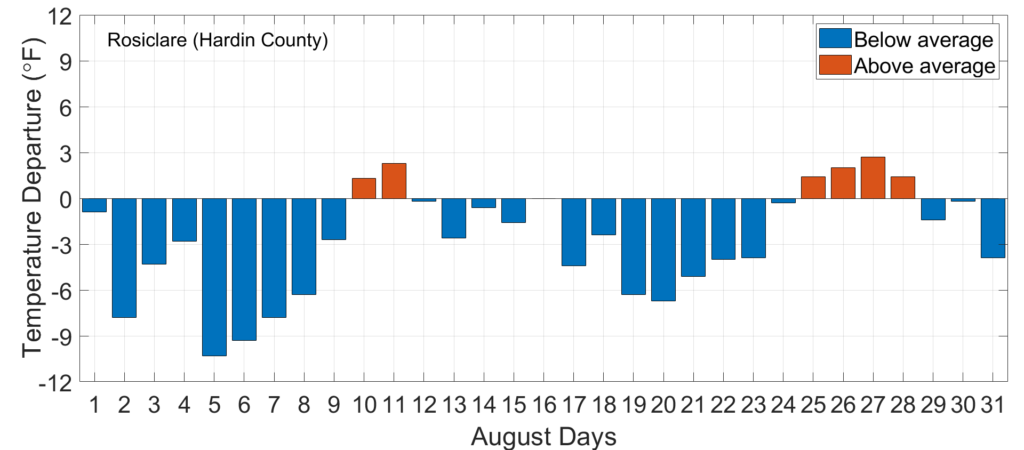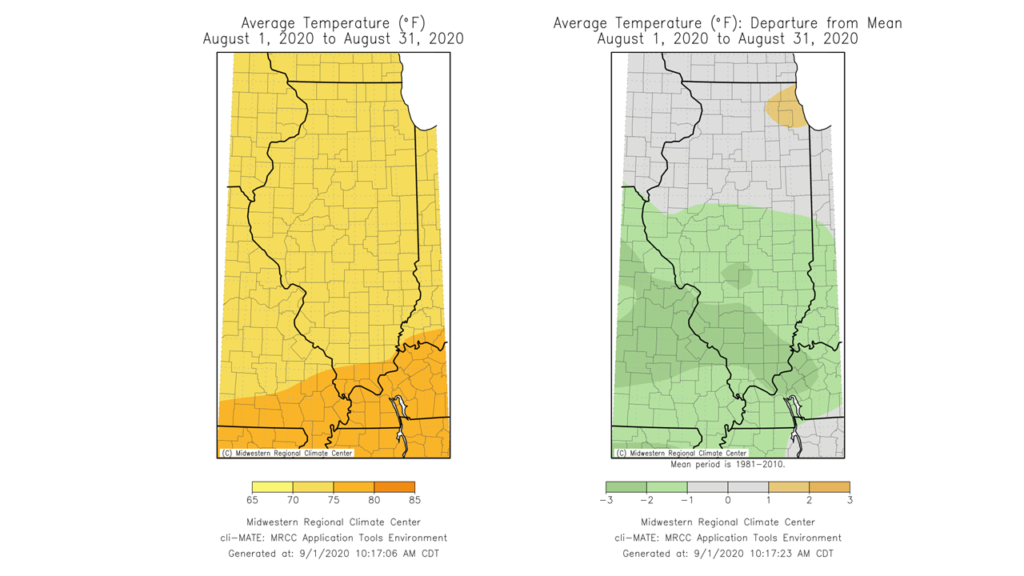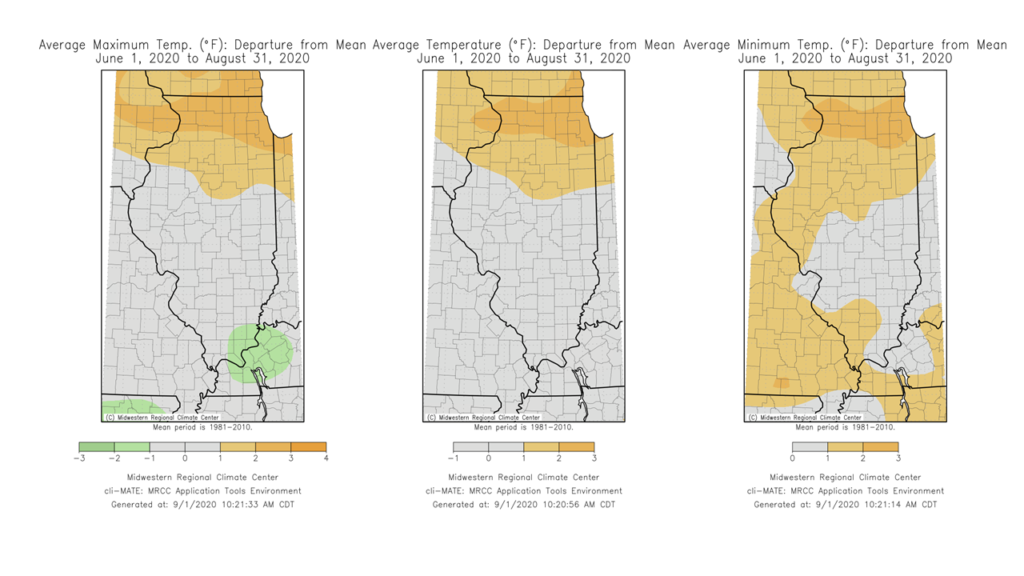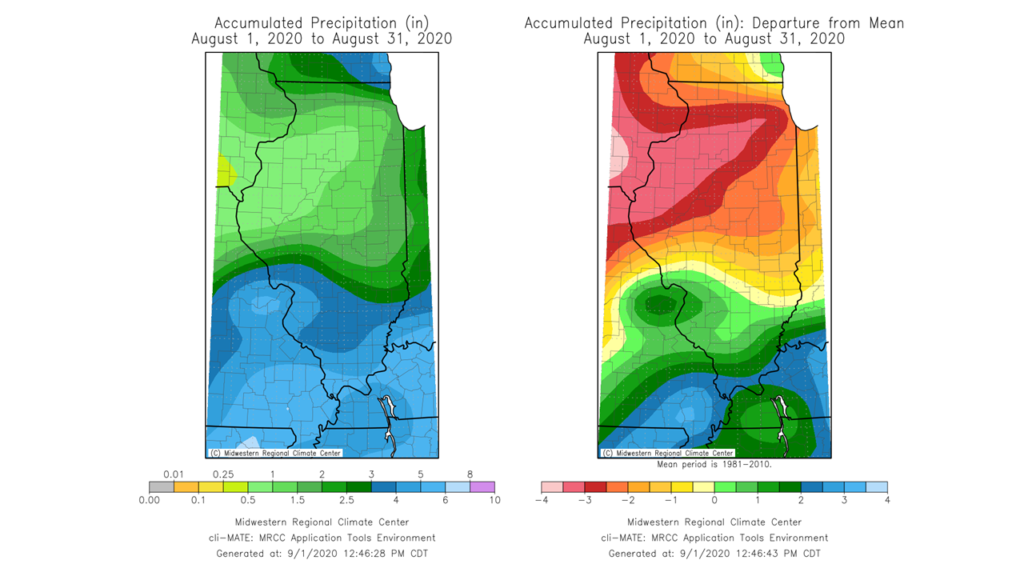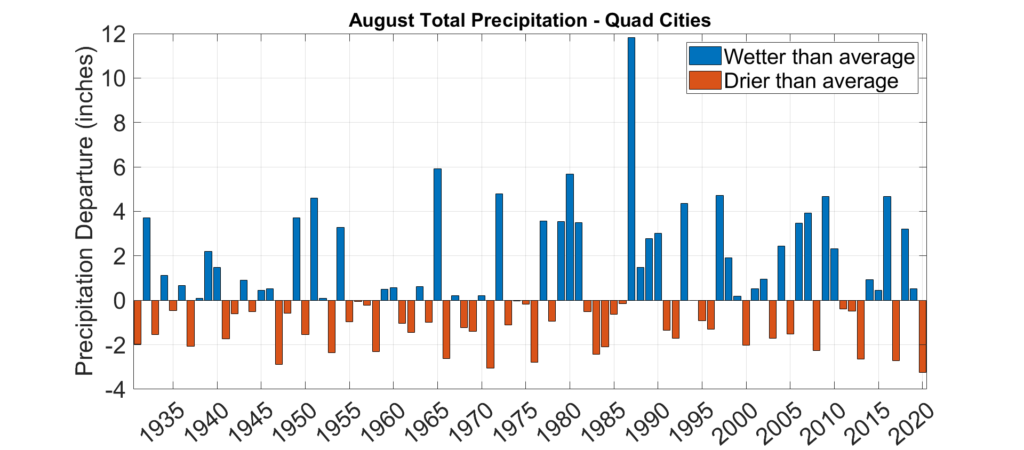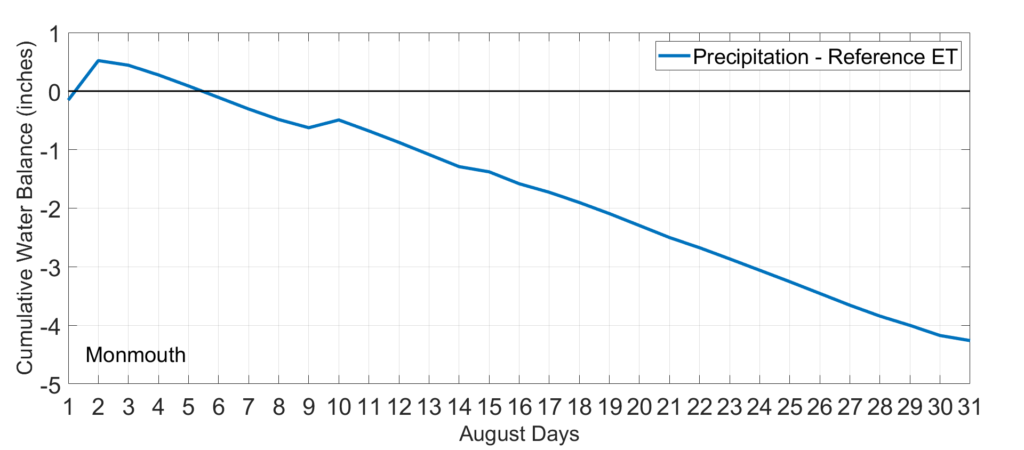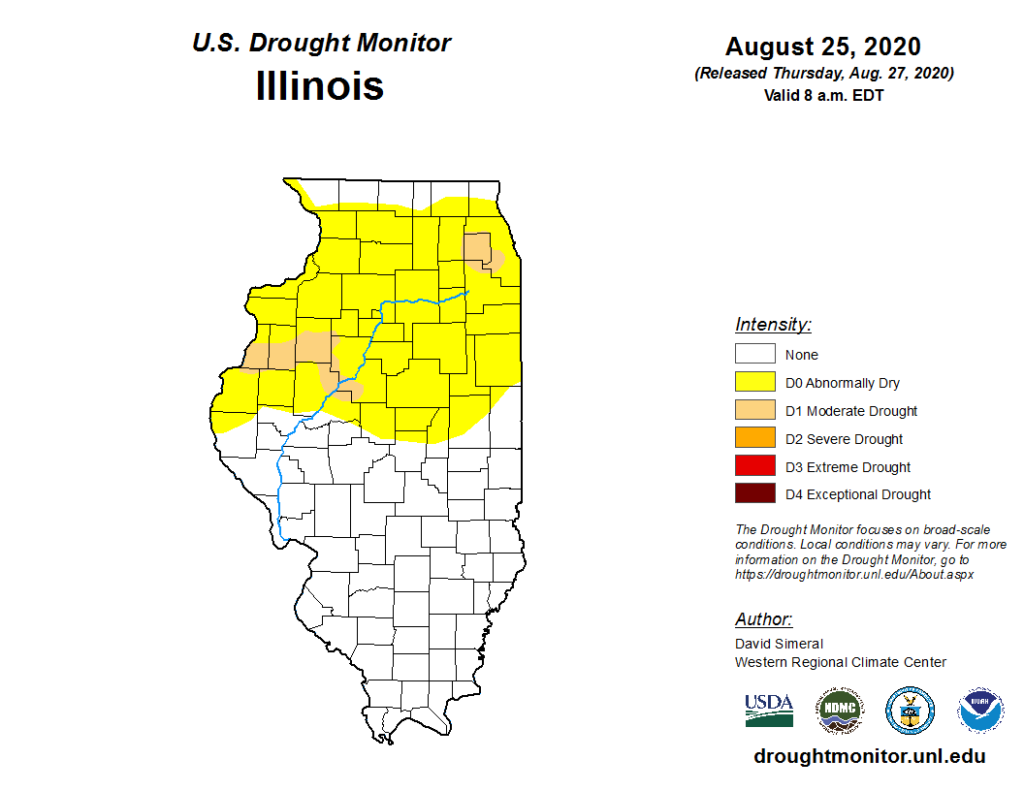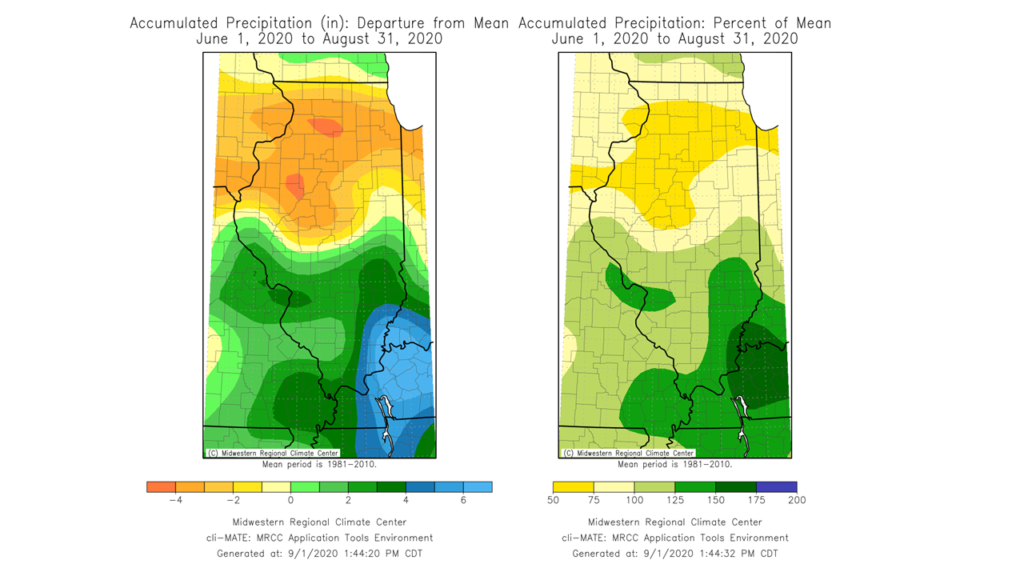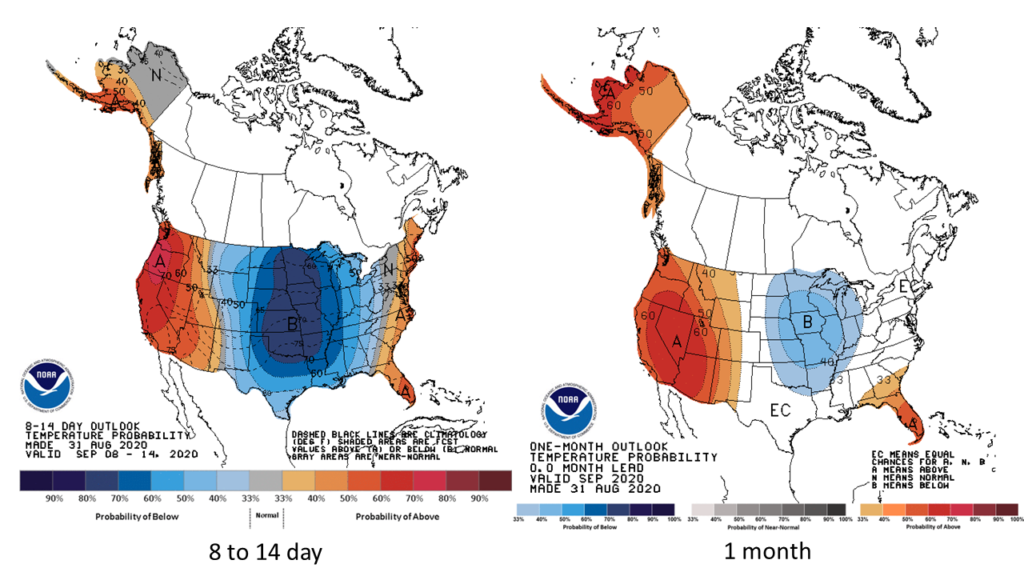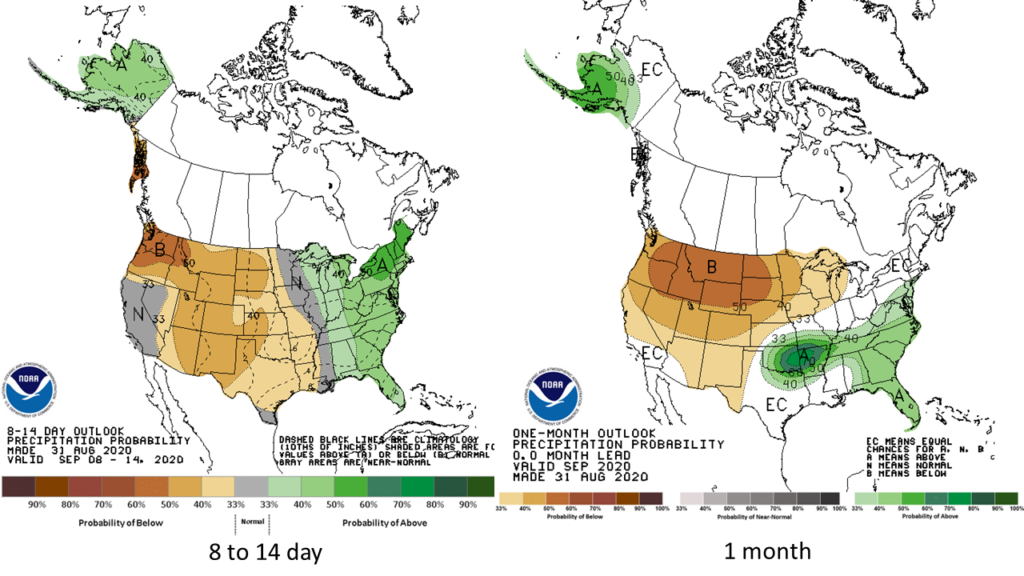November was much warmer and slightly drier than average across Illinois. The preliminary statewide average November temperature was 46.6 degrees, 4.1 degrees above the 30-year normal and tied for the 9th warmest on record. Preliminary statewide average total precipitation for November was 2.94 inches, 0.53 inches less than the 30-year normal, and the 70th driest on record.
Data are provisional and may change slightly over time
November Temperatures
Following cooler than normal months in September and October, a broad upper-level ridge established over the central U.S. and brought warm air into the Midwest. This resulted in well above average temperatures across Illinois. The plot below shows daily average temperatures in Rockford between November 3rd and 10th were 5 to 25 degrees above average. The station in Rockford recorded its highest November daily average temperature on record last month, 69 degrees on November 9th. This temperature is close to the climatological average for late September!
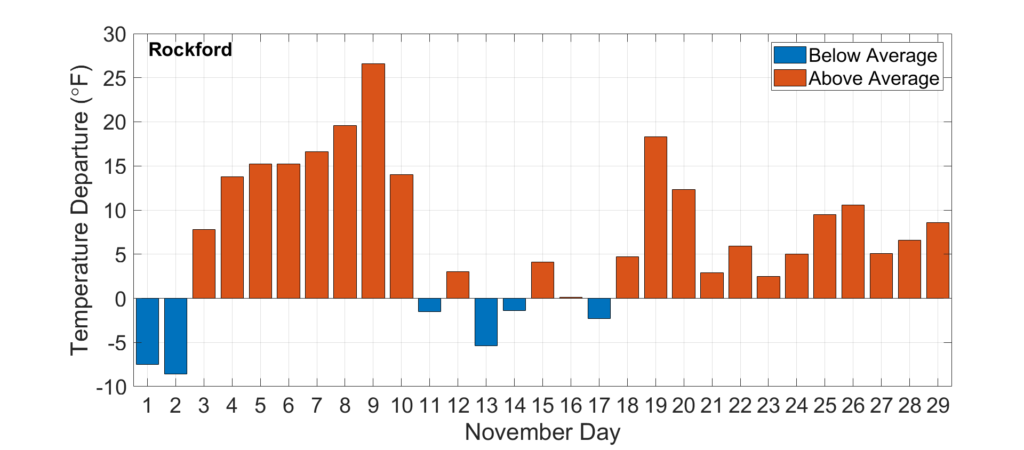
Between November 9th and 12th, 103 Illinois stations broke their daily high maximum temperature records, and 79 stations broke their daily high minimum temperature records. The Streator station in Livingston County broke its 126-year daily high minimum temperature record by 14 degrees on November 10th. Impressively, 19 stations in Illinois broke their all-time November high minimum temperature records last month. This included in Rock Island, where the 65-degree minimum temperature on November 10th was the highest minimum temperature recorded since observations began there in 1872.
Although temperatures moderated in the second and third weeks of November, temperatures mostly remained above normal throughout the rest of the month. The maps below show November average temperatures and departures across the state. Average temperatures ranged from the low 40s in northern Illinois to the low 50s in southern Illinois, between 4 and 8 degrees above average. The statewide average November temperature was 46.6 degrees, 4.1 degrees above the 30-year normal and tied for 9th warmest on record.
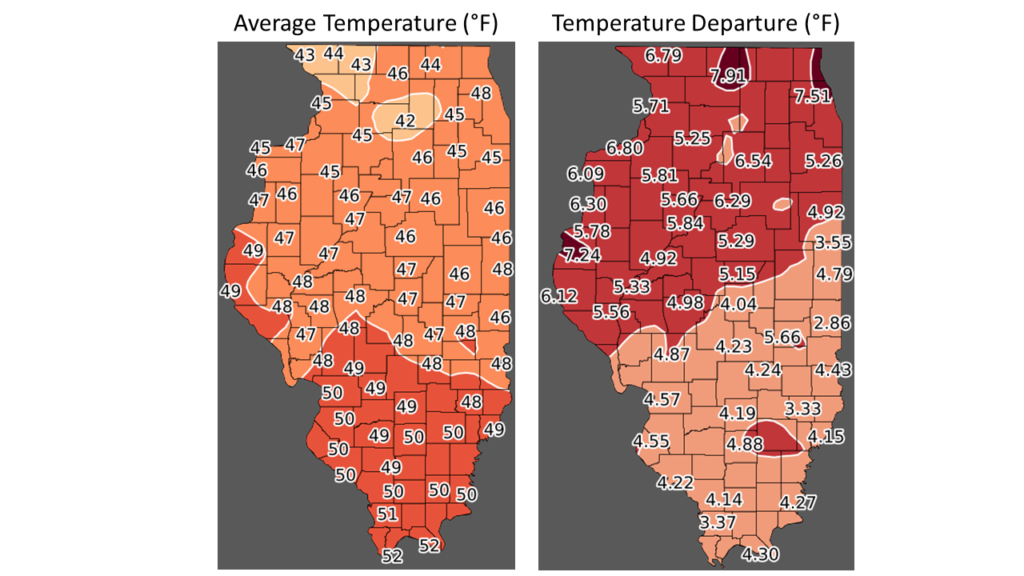
November was the temperature outlier this climatological fall season, as both September and October were cooler than normal statewide. The maps below show monthly average temperature departures in each of the three fall months. Overall, the preliminary 2020 climatological fall season average temperature was 54.7 degrees, which was 0.3 degrees above the 30-year normal and tied for 46th warmest fall on record.
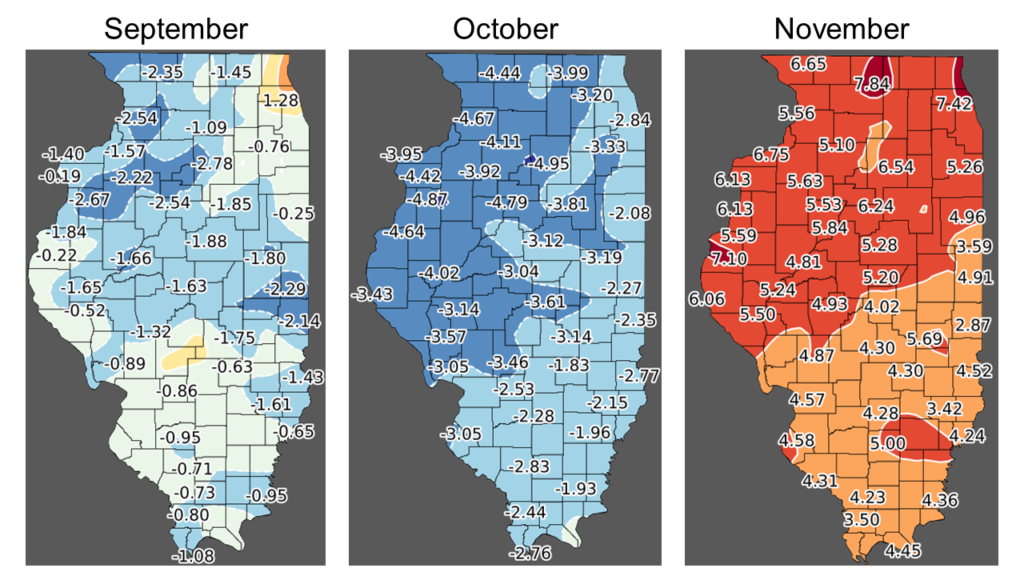
November Precipitation
Last month began with the end to daylight savings time. The ensuing onslaught of 4:30 p.m. sunsets has me quoting the great philosopher Axl Rose: “So never mind the darkness, we can still find a way. ‘Cause nothin’ lasts forever, even a cold November rain.”
As the maps below show, November total precipitation ranged from less than an inch in Iroquois and Kankakee counties in eastern Illinois to nearly 8 inches in southern Illinois. A broad area of the state from Jacksonville to Chicago was 1 to 2 inches drier than average last month, while the Interstate 64 corridor was 1 to 2 inches wetter than average. Statewide total November precipitation was 2.94 inches, approximately 0.53 inches below the 30-year normal and 70th driest on record.

As the map below shows, measurable snowfall stayed north of Interstate 72 last month, with the exception of small accumulation in Hancock and Adams counties. Areas in northwest Illinois and the far western Chicago suburbs recorded over 3 inches of November snowfall, while totals farther south remained less than an inch. A snow-free November is not unusual in central and southern Illinois, but the very high temperatures last month certainly played a role in keeping the white stuff in the northern third of the state.
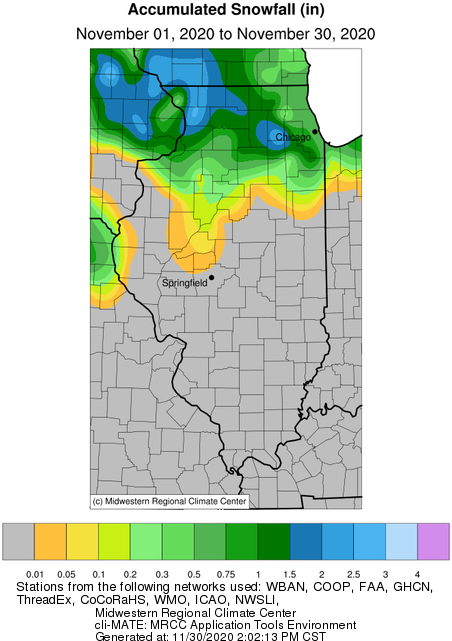
Precipitation this climatological fall season has been quite variable in northern and southern Illinois, as the maps below show. Northwest Illinois was 4 to 6 inches wetter than normal in September, while most of southern Illinois was 1 to 3 inches drier than normal. This pattern flipped in October, and far southern Illinois observed 4 to 6 inches of additional precipitation.
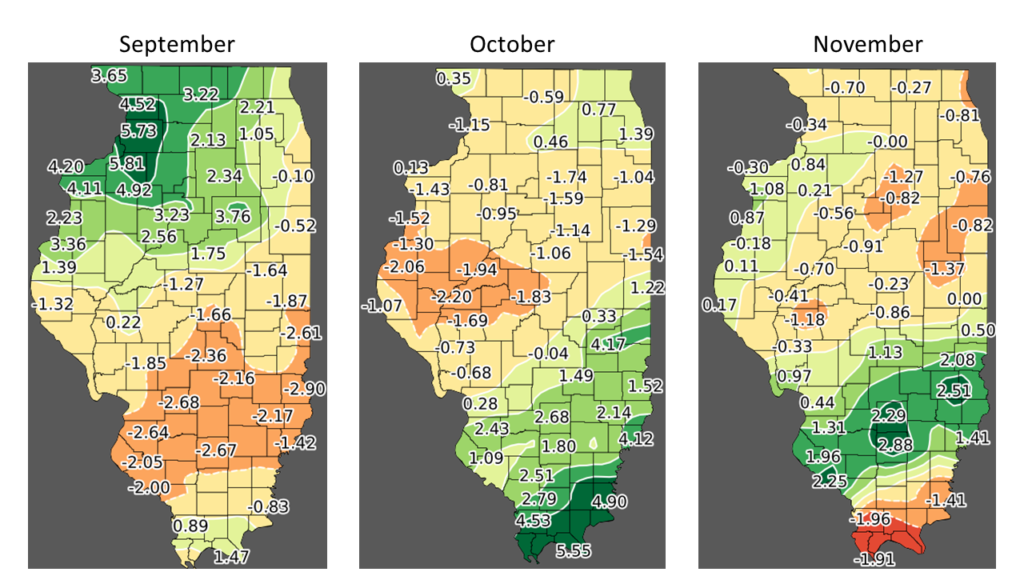
Overall, the preliminary 2020 climatological fall season total precipitation was 9.07 inches, which was 0.87 inches below the 30-year normal and 65th driest fall on record.
Drought Continues in Central Illinois
Climatological summer was drier than average for most of central Illinois, and this pattern continued throughout fall. The plot below shows that Springfield has experienced four consecutive drier than average months, with a cumulative precipitation departure over 5 inches since Aug. 1.
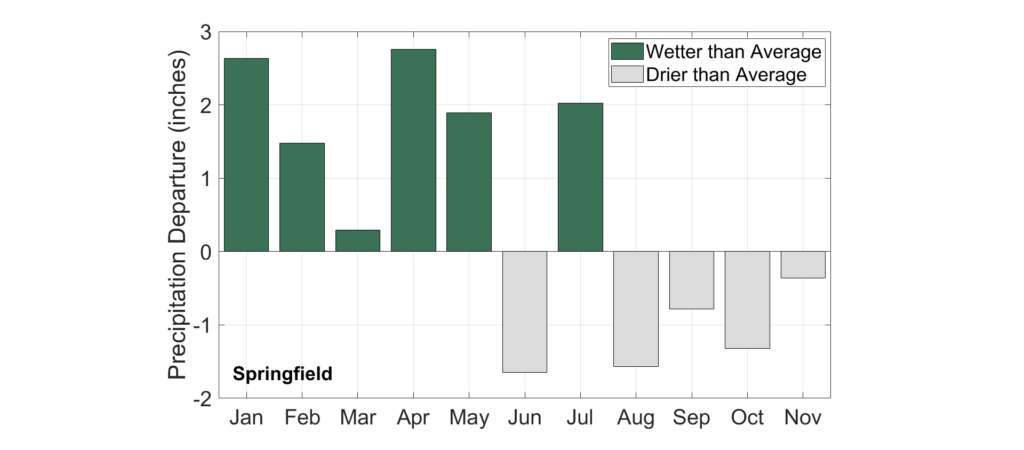
The maps below show 6-month (June–November) precipitation departure from average and percent of average statewide. An area from Fulton County to DeWitt County in central Illinois has experienced a 7 to 9 inch precipitation deficit since June 1, representing between 65% and 75% of normal 6-month precipitation.
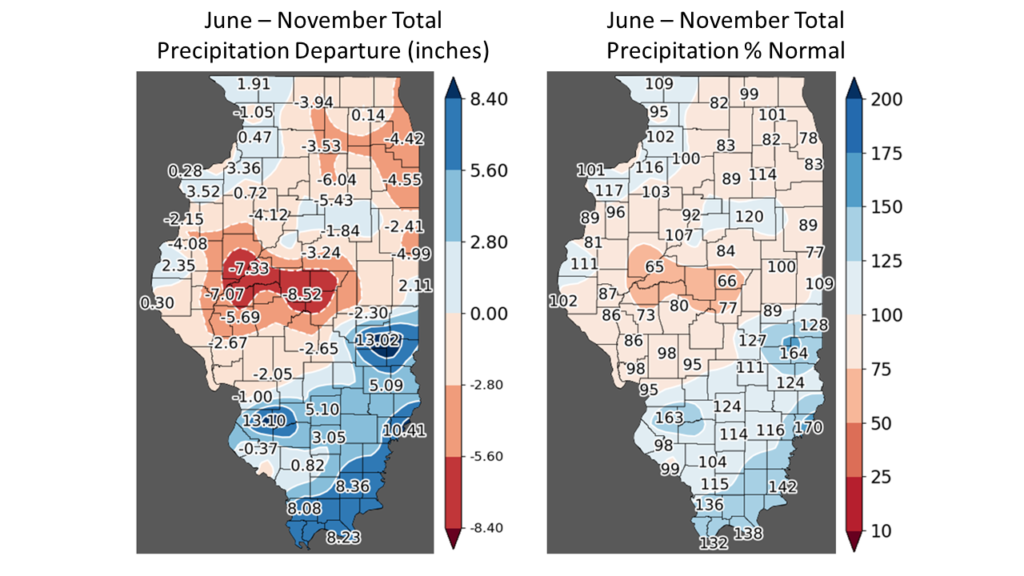
The most recent (Nov. 24) version of the U.S. Drought Monitor showed widespread moderate drought from Sangamon County to Kankakee County and severe drought in the driest area of central Illinois. Most of the state between Interstates 70 and 80 is considered abnormally dry, following below average precipitation in October and November.
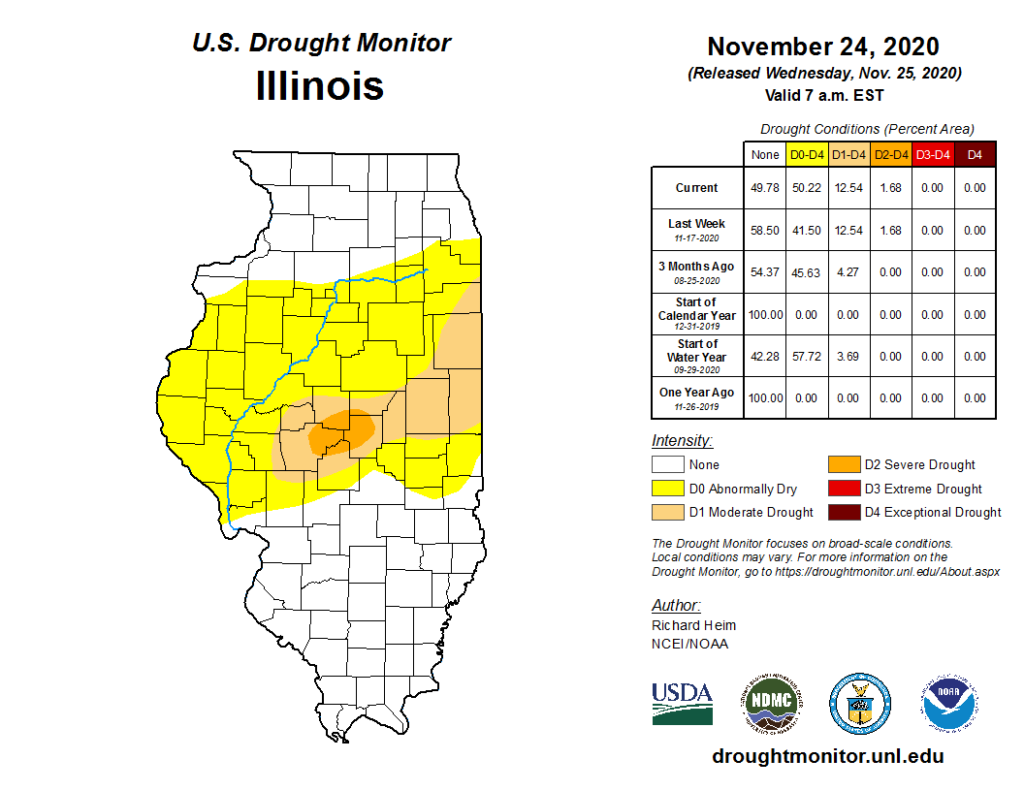
Soil moisture across the central part of the state is near normal to well below normal in response to precipitation deficit. However, despite the prolonged dryness, the figure below shows the total estimated amount of water in the top 40-inch soil column in Springfield is right at the 18-year median level. The soil water estimates are based on observations from the Illinois Climate Network.
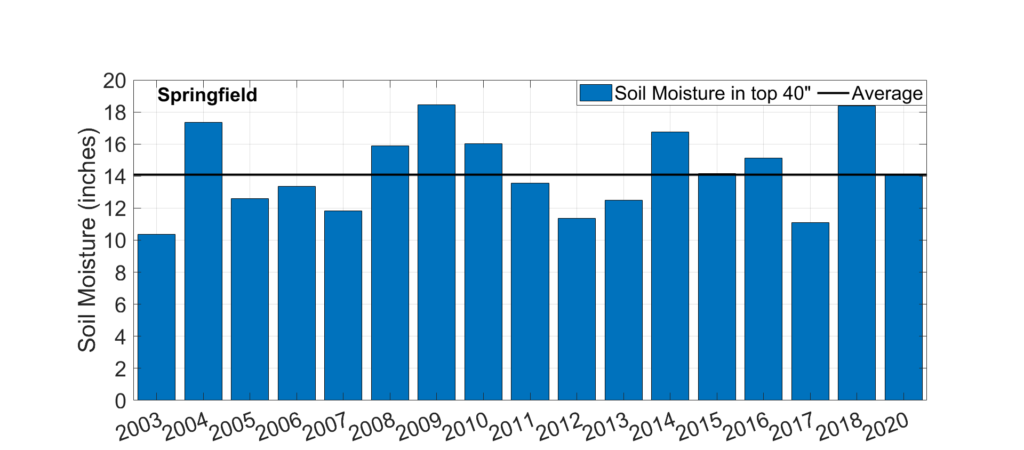
Although both top- and sub-layer soil moisture are less than in each of the last two years in central Illinois, soil moisture levels are still near to slightly below average. Therefore, a normal to wetter than normal winter season could help recharge soil moisture and reduce drought concern moving into next spring.
Outlooks
The Climate Prediction Center’s 8- to 14-day outlooks indicate highest odds of a continuation of warmer and drier than normal conditions across the state in the second week of December.
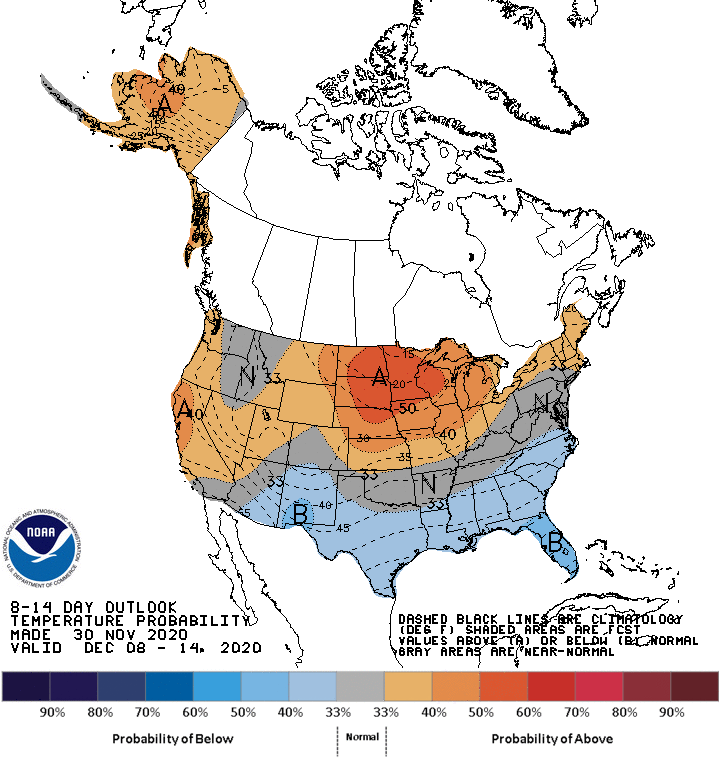
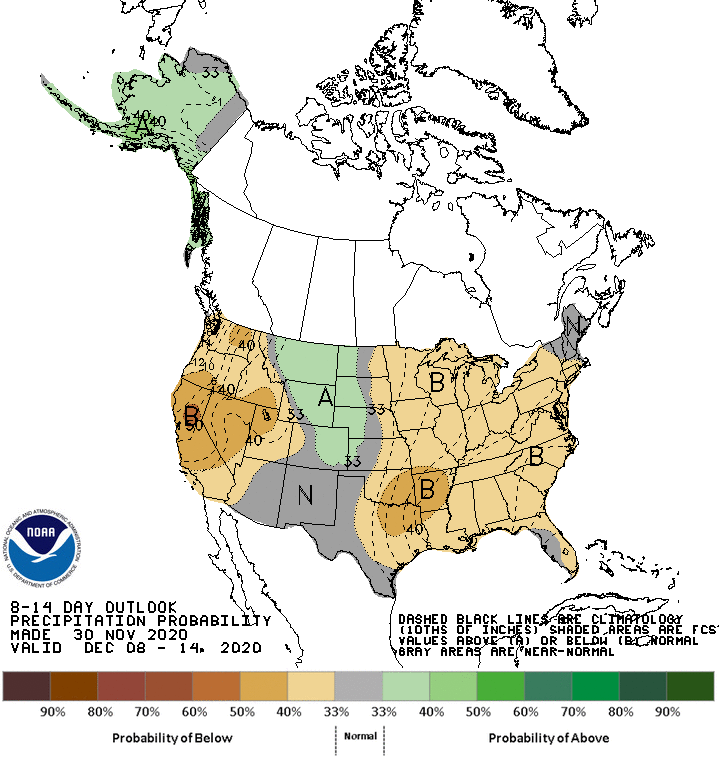
The outlooks for the entire month of December are similar, with elevated odds of above normal temperatures and below normal precipitation statewide.


Finally, the most recent three-month outlooks for climatological winter, December–February, lean into La Niña conditions with highest odds for wetter than normal weather and equal chances of warmer or colder than normal weather in Illinois.
